Apply to Aakash iACST Scholarship Test 2024
NCERT Solutions for Class 10 Maths Chapter 2 Polynomials
NCERT Solutions for Class 10 Maths Chapter 2 Polynomials
Class 10 Maths Chapter 2 Solutions Polynomials will discuss about the polynomials with any degree and its solutions using a graphical representation. These solutions are prepared by expert teachers keeping in mind the latest CBSE syllabus 2023. Also, Class 10 maths chapter 2 solutions polynomials gives a detailed explanation of questions given in the NCERT Book of Class 10 Maths.
- NCERT Solutions for Class 10 Maths Chapter 2 Polynomials
- NCERT Solutions for Class 10 Maths Chapter 2 Polynomials PDF Free Download
- NCERT Solutions for Class 10 Maths Chapter 2 Polynomials - Important Formulae
- Class 10 Maths Chapter 2 Solutions Polynomials (Intext Questions and Exercise)
- Polynomials Class 10 - Topics
- NCERT Books and NCERT Syllabus here
- NCERT Solutions for Class 10 Maths - Chapters Wise
- Features of NCERT Solutions for Class 10 Maths Chapter 2 Polynomials
- NCERT Solutions of Class 10 - Subject Wise
- How to use NCERT solutions for class 10 maths chapter 2 polynomials?
- NCERT Exemplar solutions - Subject wise
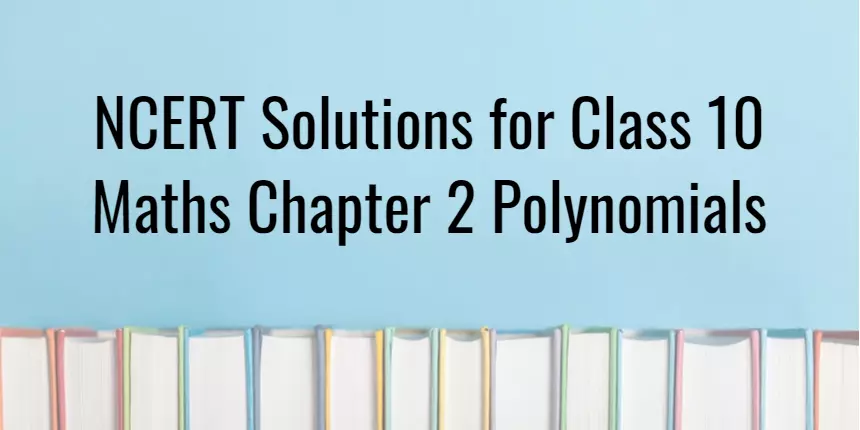
You must refer to these Polynomial Class 10 notes to check the correct answers and proper explanation of each question. These NCERT Solutions for Class 10 Maths Chapter 2 Polynomials are prepared by experts and are easy understand. You can check the NCERT solutions for Class 10 for other subjects here.
Also Read,
- NCERT Exemplar Solutions for Class 10 Maths Chapter 2 Polynomials
- Polynomials Class 10 NCERT Chapter 2 Notes
NCERT Solutions for Class 10 Maths Chapter 2 Polynomials PDF Free Download
NCERT Solutions for Class 10 Maths Chapter 2 Polynomials - Important Formulae
The general Polynomial Expression is represented as follows:
F(x) = anxn + an-1xn-1 + an-2xn-2 + ... + rx + s.
For a natural number n, an-bn = (a - b)(an-1 + an-2b + ... + bn-2a + bn-1)
When n is an even number (expressed as n = 2a),
xn + yn = (x + y)(xn-1 - xn-2y + ... + yn-2x - yn-1)
For an odd number n,
xn + yn = (x + y)(xn-1 - xn-2y + ... - yn-2x + yn-1)
Different types of polynomials encompass various essential concepts and properties, each delineated in detail in the provided table.
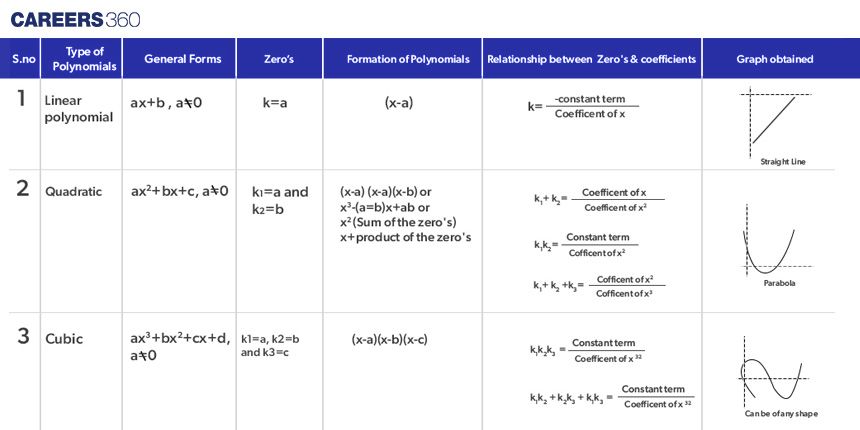
Algebraic polynomial identity
(a + b)2 = a2 + b2 + 2ab
(a - b)2 = a2 + b2 - 2ab
(a + b)(a - b) = a2 - b2
(x + a)(x + b) = x2 + (a + b)x + ab
(x + a)(x - b) = x2 + (a - b)x - ab
(x - a)(x + b) = x2 + (b - a)x - ab
(x - a)(x - b) = x2 - (a + b)x + ab
(a + b)3 = a3 + b3 + 3ab(a + b)
(a - b)3 = a3 - b3 - 3ab(a - b)
(x + y + z)2 = x2 + y2 + z2 + 2xy + 2yz + 2xz
(x + y - z)2 = x2 + y2 + z2 + 2xy - 2yz - 2xz
(x -y + z)2 = x2 + y2 + z2 - 2xy - 2yz + 2xz
(x - y - z)2 = x2 + y2 + z2 - 2xy + 2yz - 2xz
x3 + y3 + z3 - 3xyz = (x + y + z)(x2 + y2 + z2 - xy - yz - xz)
x2 + y2 = 12[(x + y)2 + (x - y)2]
(x + a)(x + b)(x + c) = x3 + (a + b + c)x2 + (ab + bc + ca)x + abc
x3 + y3 = (x + y)(x2 - xy + y2)
x3 - y3 = (x - y)(x2 + xy + y2)
x2 + y2 + z2 - xy - yz - zx = 1/2[(x - y)2 + (y - z)2 + (z - x)2]
SAT® | CollegeBoard
Registeration closing on 19th Apr for SAT® | One Test-Many Universities | 90% discount on registrations fee | Free Practice | Multiple Attempts | no penalty for guessing
TOEFL ® Registrations 2024
Thinking of Studying Abroad? Think the TOEFL® test. Save 10% on your TOEFL exam with ApplyShop gift cards!
The division algorithm for polynomials states that when considering any two polynomials p(x) and g(x). Where g(x) is not equal to zero, Then we can find polynomials q(x) and r(x) such that:
p(x) = q(x) g(x) + r(x)
Here, r(x) = 0 or deg r(x) ≥ deg g(x)
Free download NCERT Solutions for Class 10 Maths Chapter 2 Polynomials PDF for CBSE Exam.
Class 10 Maths Chapter 2 Solutions Polynomials (Intext Questions and Exercise)
NCERT Solutions for Chapter 2 Maths Class 10 Polynomials Excercise: 2.1
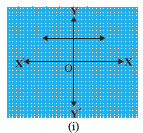
Answer: The number of zeroes of p(x) is zero as the curve does not intersect the x-axis.

Answer: The number of zeroes of p(x) is one as the graph intersects the x-axis only once.

Answer: The number of zeroes of p(x) is three as the graph intersects the x-axis thrice.
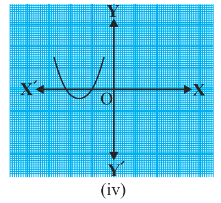
Answer: The number of zeroes of p(x) is two as the graph intersects the x-axis twice.

Answer: The number of zeroes of p(x) is four as the graph intersects the x-axis four times.
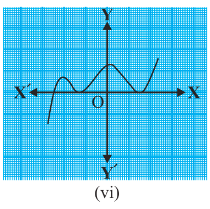
Answer: The number of zeroes of p(x) is three as the graph intersects the x-axis thrice.
Class 10 Maths Chapter 2 Solutions Polynomials Excercise: 2.2
Answer:
x 2 - 2x - 8 = 0
x 2 - 4x + 2x - 8 = 0
x(x-4) +2(x-4) = 0
(x+2)(x-4) = 0
The zeroes of the given quadratic polynomial are -2 and 4
VERIFICATION
Sum of roots:
Verified
Product of roots:
Verified
Answer:
The zeroes of the given quadratic polynomial are 1/2 and 1/2
VERIFICATION
Sum of roots:
Verified
Product of roots:
Verified
Answer:
6x 2 - 3 - 7x = 0
6x 2 - 7x - 3 = 0
6x 2 - 9x + 2x - 3 = 0
3x(2x - 3) + 1(2x - 3) = 0
(3x + 1)(2x - 3) = 0
The zeroes of the given quadratic polynomial are -1/3 and 3/2
Sum of roots:
Verified
Product of roots:
Verified
Answer: 4u 2 + 8u = 0
4u(u + 2) = 0
The zeroes of the given quadratic polynomial are 0 and -2
VERIFICATION
Sum of roots:
Verified
Product of roots:
Verified
Answer: t 2 - 15 = 0
The zeroes of the given quadratic polynomial are and
VERIFICATION
Sum of roots:
Verified
Product of roots:
Verified
Answer: 3x 2 - x - 4 = 0
3x 2 + 3x - 4x - 4 = 0
3x(x + 1) - 4(x + 1) = 0
(3x - 4)(x + 1) = 0
The zeroes of the given quadratic polynomial are 4/3 and -1
VERIFICATION
Sum of roots:
Verified
Product of roots:
Verified
Answer:
The required quadratic polynomial is
Answer:
The required quadratic polynomial is
Answer:
The required quadratic polynomial is x 2 + .
Answer:
The required quadratic polynomial is x 2 - x + 1
Answer:
The required quadratic polynomial is 4x 2 + x + 1
Answer:
The required quadratic polynomial is x 2 - 4x + 1
NCERT Solutions for Chapter 2 Maths Class 10 Polynomials Excercise: 2.3
Answer: The polynomial division is carried out as follows
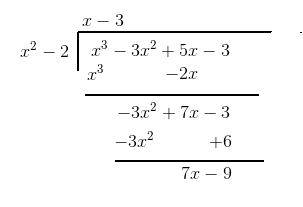
The quotient is x-3 and the remainder is 7x-9
Answer:
The division is carried out as follows
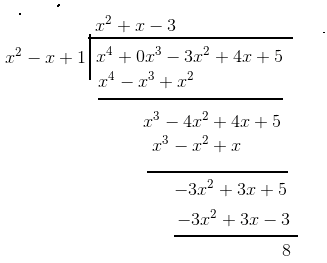
The quotient is
and the remainder is 8
Answer: The polynomial is divided as follows
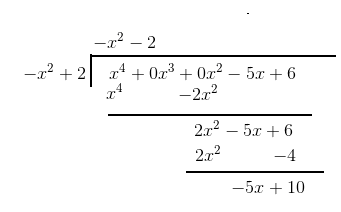
The quotient is and the remainder is
Answer:

After dividing we got the remainder as zero. So is a factor of
Answer: To check whether the first polynomial is a factor of the second polynomial we have to get the remainder as zero after the division
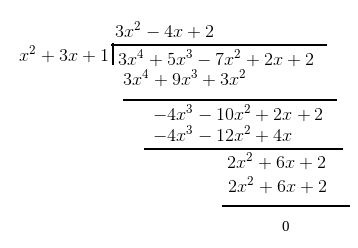
After division, the remainder is zero thus is a factor of
Answer: The polynomial division is carried out as follows
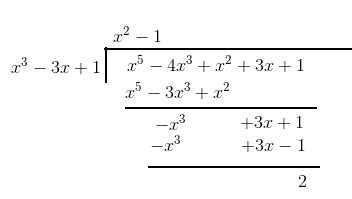
The remainder is not zero, there for the first polynomial is not a factor of the second polynomial
Q3 Obtain all other zeroes of , if two of its zeroes are
Answer:
Two of the zeroes of the given polynomial are .
Therefore two of the factors of the given polynomial are and
is a factor of the given polynomial.
To find the other factors we divide the given polynomial with
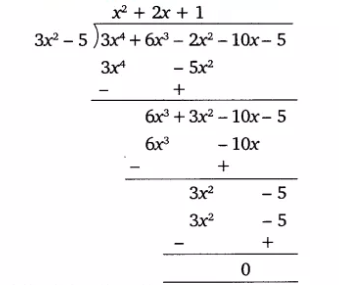
The quotient we have obtained after performing the division is
(x+1) 2 = 0
x = -1
The other two zeroes of the given polynomial are -1.
Answer: Quotient = x-2
remainder =-2x+4

Carrying out the polynomial division as follows

Answer: deg p(x) will be equal to the degree of q(x) if the divisor is a constant. For example
Q5 (2) Give examples of polynomials p(x), g(x), q(x) and r(x), which satisfy the division algorithm and deg q(x) = deg r(x)
Answer: Example for a polynomial with deg q(x) = deg r(x) is given below

Answer:
example for the polynomial which satisfies the division algorithm with r(x)=0 is given below
NCERT Solutions for Class 10 Maths Chapter 2 Polynomials Excercise: 2.4
Answer:
p(x) = 2x 3 + x 2 -5x + 2
p(1) = 2 x 1 3 + 1 2 - 5 x 1 + 2
p(1) =2 + 1 - 5 + 2
p(1) = 0
p(-2) = 2 x (-2) 3 + (-2) 2 - 5 x (-2) +2
p(-2) = -16 + 4 + 10 + 2
p(-2) = 0
Therefore the numbers given alongside the polynomial are its zeroes
Verification of relationship between the zeroes and the coefficients
Comparing the given polynomial with ax 3 + bx 2 + cx + d, we have
a = 2, b = 1, c = -5, d = 2
The roots are
Verified
Verified
Verified
Answer:
p(x) = x 3 - 4x 2 + 5x - 2
p(2) = 2 3 - 4 x 2 2 + 5 x 2 - 2
p(2) = 8 - 16 + 10 - 2
p(-2) = 0
p(1) = 1 3 - 4 x 1 2 + 5 x 1 - 2
p(1) = 1 - 4 + 5 - 2
p(1) = 0
Therefore the numbers given alongside the polynomial are its zeroes
Verification of relationship between the zeroes and the coefficients
Comparing the given polynomial with ax 3 + bx 2 + cx + d, we have
a = 1, b = -4, c = 5, d = -2
The roots are
Verified
Verified
Verified
Answer: Let the roots of the polynomial be 

Hence the required cubic polynomial is x 3 - 2x 2 - 7x + 14 = 0
Q3 If the zeroes of the polynomial are a – b, a, a + b, find a and b.
Answer:
The roots of the above polynomial are a, a - b and a + b
Sum of the roots of the given plynomial = 3
a + (a - b) + (a + b) = 3
3a = 3
a = 1
The roots are therefore 1, 1 - b and 1 + b
Product of the roots of the given polynomial = -1
1 x (1 - b) x (1 + b) = - 1
1 - b 2 = -1
b 2 - 2 = 0
Therefore a = 1 and .
Q4 If two zeroes of the polynomial
are
, find other zeroes .
Answer: Given the two zeroes are
therefore the factors are
We have to find the remaining two factors. To find the remaining two factors we have to divide the polynomial with the product of the above factors
Now carrying out the polynomial division
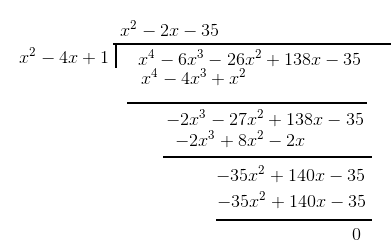
Now we get
So the zeroes are
Answer: The polynomial division is carried out as follows
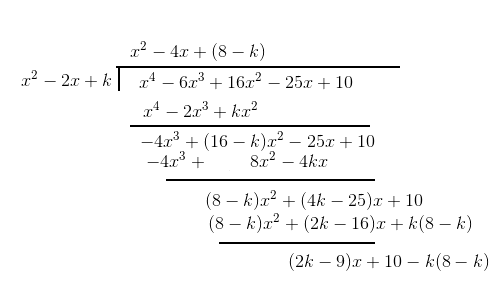
Given the remainder =x+a
The obtained remainder after division is
now equating the coefficient of x
which gives the value of
now equating the constants
Therefore k=5 and a=-5
Polynomials Class 10 - Topics
The degree of a polynomial
Number of zeroes in a quadratic polynomial
The sum & product of quadratic polynomial
Division algorithm
The number of zeroes in a cubic polynomial
NCERT Books and NCERT Syllabus here
NCERT Solutions for Class 10 Maths - Chapters Wise
Chapter No. | Chapter Name |
Chapter 1 | |
Chapter 2 | Polynomials |
Chapter 3 | |
Chapter 4 | |
Chapter 5 | |
Chapter 6 | |
Chapter 7 | |
Chapter 8 | |
Chapter 9 | |
Chapter 10 | |
Chapter 11 | |
Chapter 12 | |
Chapter 13 | |
Chapter 14 | |
Chapter 15 |
Features of NCERT Solutions for Class 10 Maths Chapter 2 Polynomials
The chapter 2 Maths Class 10 are important for board exams as well as for competitive exams.
These NCERT solutions are prepared by experts. These solutions are very well explained and are to the point.
To make the Class 10 Maths chapter 2 solutions easy to understand, relevant diagrams or images are given with the solutions wherever required.
You can check these solutions online or can save the webpage to get these solutions offline. NCERT Solutions for Class 10 Maths Chapter 2 PDF download will also be made available soon.
Also See,
- Polynomials Class 10 Exercise 2.1
- Polynomials Class 10 Exercise 2.2
- Polynomials Class 10 Exercise 2.3
- Polynomials Class 10 Exercise 2.4
NCERT Solutions of Class 10 - Subject Wise
How to use NCERT solutions for class 10 maths chapter 2 polynomials?
You will find yourself much improved in terms of concepts, their applications, and problem-solving. 90% of the questions in the board examinations come from the NCERT syllabus.
Now when you have gone through the NCERT solutions for Maths chapter 2 Polynomials Class 10 , you must have learnt to answer a question in the step by step manner.
Once you have studied the Class 10 Maths chapter 2 NCERT solutions, your next target should be previous year questions papers.
NCERT syllabus coverage and previous year papers are enough tools to get a good score in the board examination. After going through these two things, you can jump to the next chapters.
NCERT Exemplar solutions - Subject wise
Frequently Asked Question (FAQs)
At the careers360 official website, you can find polynomials class 10 ncert solutions. These solutions for ch2 maths class 10 are designed and developed by reliable experts keeping in mind the new pattern provided by the state and central boards. Also, you can download it as a polynomials class 10 pdf.
The topics covered in NCERT maths class 10 chapter 2 (Polynomials) are:
Definition and types of polynomials
Zeroes of a polynomial
Division algorithm for polynomials
Fundamental Theorem of Algebra
Relationship between zeroes and coefficients of a polynomial
Nature of roots of a polynomial
There are several reasons why you should use the ncert solutions for class 10 maths chapter 2 polynomials:
The NCERT Solutions are accurate and reliable
The NCERT Solutions cover all the concepts and exercises given in the textbook
The NCERT Solutions can help you develop problem-solving skills
The NCERT Solutions can be used as a reference guide
Overall, using the polynomials class 10 questions with answers can be a useful resource for students to improve their understanding of the concepts and perform well in exams.
There are a total of 10 exercises in Chapter 2 (Polynomials) of the NCERT Solutions for Class 10 Mathematics. These exercises consist of a variety of questions, including multiple choice questions, fill in the blanks, true or false, and short answer questions. The number of questions in each exercise may vary.
According to the NCERT chapter 2 Class 10 Maths Polynomials, a polynomial is a mathematical expression that consists of variables (such as x, y, etc.) and coefficients (numbers), which are combined using only the operations of addition, subtraction, and multiplication.
Also Read
Articles
Certifications By Top Providers
Explore Top Universities Across Globe
Questions related to CBSE Class 10th
Dear aspirant !
Hope you are doing well ! The class 10 Hindi mp board sample paper can be found on the given link below . Set your time and give your best in the sample paper it will lead to great results ,many students are already doing so .
Hope you get it !
Thanking you
Hello aspirant,
The dates of the CBSE Class 10th and Class 12 exams are February 15–March 13, 2024 and February 15–April 2, 2024, respectively. You may obtain the CBSE exam date sheet 2024 PDF from the official CBSE website, cbse.gov.in.
To get the complete datesheet, you can visit our website by clicking on the link given below.
https://school.careers360.com/boards/cbse/cbse-date-sheet
Thank you
Hope this information helps you.
Hello aspirant,
The paper of class 7th is not issued by respective boards so I can not find it on the board's website. You should definitely try to search for it from the website of your school and can also take advise of your seniors for the same.
You don't need to worry. The class 7th paper will be simple and made by your own school teachers.
Thank you
Hope it helps you.
The eligibility age criteria for class 10th CBSE is 14 years of age. Since your son will be 15 years of age in 2024, he will be eligible to give the exam.
That totally depends on what you are aiming for. The replacement of marks of additional subjects and the main subject is not like you will get the marks of IT on your Hindi section. It runs like when you calculate your total percentage you have got, you can replace your lowest marks of the main subjects from the marks of the additional subject since CBSE schools goes for the best five marks for the calculation of final percentage of the students.
However, for the admission procedures in different schools after 10th, it depends on the schools to consider the percentage of main five subjects or the best five subjects to admit the student in their schools.
Popular CBSE Class 10th Questions
Colleges After 12th
Also Read
Applications for Admissions are open.

JEE Main Important Physics formulas
ApplyAs per latest 2024 syllabus. Physics formulas, equations, & laws of class 11 & 12th chapters

UPES School of Liberal Studies
ApplyRanked #52 Among Universities in India by NIRF | Up to 30% Merit-based Scholarships | Lifetime placement assistance

Aakash iACST Scholarship Test 2024
ApplyGet up to 90% scholarship on NEET, JEE & Foundation courses

JEE Main Important Chemistry formulas
ApplyAs per latest 2024 syllabus. Chemistry formulas, equations, & laws of class 11 & 12th chapters

PACE IIT & Medical, Financial District, Hyd
ApplyEnrol in PACE IIT & Medical, Financial District, Hyd for JEE/NEET preparation

ALLEN JEE Exam Prep
ApplyStart your JEE preparation with ALLEN
